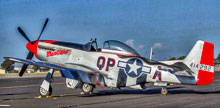P-38 Lightning

The Lockheed P-38 Lightning was a World War II American fighter aircraft built by Lockheed. Its distinctive design featured twin booms and a single, central nacelle, which contained the cockpit and armament. Luftwaffe pilots called it the “fork-tailed devil”, while the Japanese referred to it as “two planes, one pilot”.
A Brief History Of The Lockheed P38 Lightning
The Lockheed P-38 Lightning was a World War II American fighter aircraft built by Lockheed. Its distinctive design featured twin booms and a single, central nacelle, which contained the cockpit and armament. Luftwaffe pilots called it the “fork-tailed devil”, while the Japanese referred to it as “two planes, one pilot”. A versatile aircraft, the P-38 found use in a number of roles, including dive bombing, level bombing, ground-attack, photo recon, and as a long-range escort fighter.
The P-38 saw its greatest success in the Pacific and China-Burma-India Theaters. Top American aces Richard Bong (40 victories) and Thomas McGuire (38 victories) were P-38 pilots. In the South West Pacific theater, it was the primary long-range fighter of US Army Air Forces until the arrival of the P-51, late in the war. The P-38 was an extremely forgiving plane to fly, and could be mishandled in many ways, but it did not excel in dogfights. It was the only American fighter aircraft in continuous production throughout American involvement in WW II.
In the Pacific theater, the P-38 shot down over 1,800 Japanese aircraft, with more than 100 American pilots becoming aces by downing five or more enemy aircraft.
The end of the war left the USAF with thousands of P-38s made obsolete by the jet age. The last P-38s in service were retired in 1949.
As of today, a mere 12 P-38s are rated as airworthy. A half-dozen more are on display at museums across the country. Five airframes are under restoration.
|
Specifications |
|
|
Role |
Heavy Fighter |
|
Manufacturer |
Lockheed |
|
Designer |
Clarence “Kelly” Johnson |
|
First flight |
January 27, 1939 |
|
Propulsion |
|
|
Twin-engine |
Allison V-1710-111/113 V-12 piston engine, 1,725 hp [N 7] (1,194 kW) each |
|
Performance |
|
|
Max speed |
443 m/h |
|
Initial rate of climb |
4,750 ft/m |
|
Service ceiling |
44,000 ft |
|
Max range (no reserves) |
1,300m |
|
Weight (empty) |
12,800 lbs |
|
Max takeoff |
21,600 lbs |
|
Dimensions |
|
|
Wing span |
52′ |
|
Length |
37′ 10″ |
|
Height |
12′ 10″ |
|
Wing area |
327.5 sq ft |
|
Seating Capacity |
1 |
|
Armament |
|
|
• 1× Hispano M2(C) 20 mm cannon with 150 rounds |
|
|
• 4× Browning MG53-2 0.50 in (12.7 mm) machine guns with 500 rpg. |
|
|
• 4× M10 three-tube 4.5 in (112 mm) rocket launchers; or |
|
|
• Inner hardpoints: |
|
|
• 2× 2,000 lb (907 kg) bombs or drop tanks; or |
|
|
• 2× 1,000 lb (454 kg) bombs or drop tanks, plus either |
|
|
• 4× 500 lb (227 kg) bombs; or |
|
|
• 4× 250 lb (113 kg) bombs; or |
|
|
• 6× 500 lb (227 kg) bombs; or |
|
|
• 6× 250 lb (113 kg) bombs |
|
|
• Outer hardpoints: |
|
|
• 10× 5 in (127 mm) HVARs (High Velocity Aircraft Rockets); or |
|
|
• 2× 500 lb (227 kg) bombs; or |
|
|
• 2× 250 lb (113 kg) bombs |
|














































